If there is an ancient civilization so iconic and powerful that in history it achieved a great development in the sciences, arts, religion and commerce, it is the Egyptian one.
It impresses with the majesty of its pyramids, monuments covered with hieroglyphs carved into its walls, temples and cultural richness. Including its many mysteries and riddles still unsolved by scientists and archaeologists.
There is much more to Egypt than has been discovered. New findings are being made each time. It is as if that splendid civilisation is emerging again. ⠀⠀⠀⠀⠀⠀⠀⠀⠀
Some mandatory visits
The visit to the temples of Egypt is an almost religious experience.
It is amazing to see the achievements of a civilization in the middle of the desert 5 or 4 thousand years ago… Achievements that amaze even today.
Entering a temple is accompanied by a special recollection, admiration and respect for the majesty of its constructions, regardless of whether it is not religious. One does nothing but think, to try to imagine what such a culture should have been like in its heyday.
Returning to Cairo after one of those visits was like returning to a village after visiting New York, despite the millennia that have passed since the demise of Egyptian civilization.
These are the temples that we visited and that we recommend.
Abu Simbel Temple
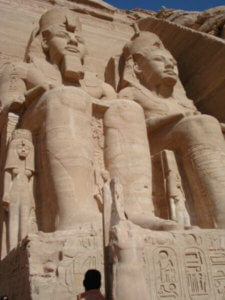 To get to Abu Simbel, south of Egypt you must first reach the city of Aswán.
To get to Abu Simbel, south of Egypt you must first reach the city of Aswán.
From there you take a bus or taxi to Abu Simbel. That journey is going to take about three hours to get to the temple.
As we said before, we went with the tour package bus. But in the end we realized that a taxi hired on your own was much, much, much cheaper. This is a point that they will not tell you either in the hotel, or your travel agency and less your tour operator!
Abu Simbel is an extraordinary archaeological monument that took about 20 years to complete. They are two temples next to each other, carved directly into the rock. They were built under the command of Ramesses II to commemorate the victory of the Battle of Qadesh thus showing their power to their neighbors.
But as with these great autocrats (and the pharaoh was a living god), this shrine was also dedicated to the greatness and divinity of Ramesses II himself. The other shrine commemorates his favorite wife Nefertari.
Inside the temples, there are four statues of four gods. Twice a year, exactly on October 21 and February 21, the sun penetrates the temple and illuminates the faces of three figures. And there is one who remains in the dark: the god Ptah, god of the underworld.
An incredible thing about these temples is that they were moved 200 meters, block by block, in the 60s so that they would not be submerged in the water by the construction of the Aswán Dam. You see those temples and you wonder “How could they move such a complex stone by stone?”
Temple Edfu
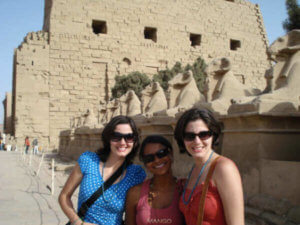 The second temple that we recommend visiting is the temple of Edfu. Dedicated to the god Horus, it is one of the best preserved temples in Egypt.
The second temple that we recommend visiting is the temple of Edfu. Dedicated to the god Horus, it is one of the best preserved temples in Egypt.
The interesting thing about this temple is that it has on its columns and walls engraved figures that move you back in time. There, the Egyptians expressed their way of life, customs, daily tasks. In these inscriptions they talk about their language, myths, legends, religion, etc.
In Ancient Egypt, people loved to tell everything they did. These scenes are invaluable in immersing us in a way of life that disappeared millennia ago.
That gives you a perspective of your own place and time. Because you see people in everyday work from 4,000 years ago and somehow you realize they’re not that different from us today.
At the time of its discovery, Edfu was under 12 meters of sand. That fact explains why it is one of the temples that is best preserved.
According to the story, Edfu was attacked by Christians who destroyed a large part of its reliefs because they considered them pagans. However, despite that and as we said, the temple is maintained and preserved in very good condition.
Kom Ombo Temple
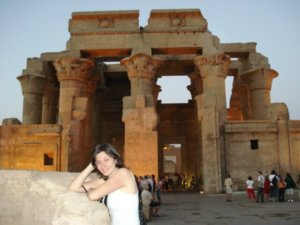 It lies north of Aswán, about 40 kilometers away. This temple is a military fortification of the Egyptian dynasties. It was built with stones that were obtained from the neighboring quarries.
It lies north of Aswán, about 40 kilometers away. This temple is a military fortification of the Egyptian dynasties. It was built with stones that were obtained from the neighboring quarries.
We especially loved the beautiful sunsets facing the Nile River that are enjoyed from this temple. Safety pins!
Luxor Temple
Luxor is another star of Egypt and it is advisable to see it at night because it is quite illuminated.
This is a temple dedicated to Amon, god of the wind. It has a large number of colossal columns. The entire temple is of imposing dimensions, which is precisely what most captures the attention of tourists, historians, and archaeologists.
Luxor has undergone many modifications. It was originally dedicated to the cult of Amon-Ra. But as time has gone on, it has been used by other religions. That temple was dominated first by the Greeks, then by the Romans, Christians and finally the Muslims Currently there is a mosque.
Karnak Temple
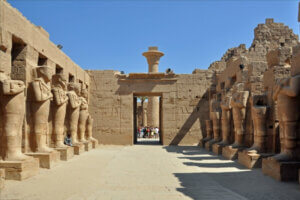 A few kilometers in front of Luxor, this temple has three shrines that are dedicated to three important gods at the time: Amon, Mut and Montu.
A few kilometers in front of Luxor, this temple has three shrines that are dedicated to three important gods at the time: Amon, Mut and Montu.
One of the most interesting things about this temple is that there is a majestic hall of 134 colossal columns, each possessing extraordinary inscriptions and hieroglyphs. This temple took approximately 1,200 years to build.
The Pharaoh
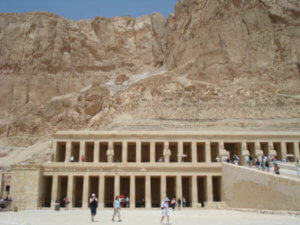 No, it wasn’t Maria Felix, the Mexican actress. She was a true pharaoh, more powerful than the famous Cleopatra.
No, it wasn’t Maria Felix, the Mexican actress. She was a true pharaoh, more powerful than the famous Cleopatra.
To be a pharaoh, you had to be a man. In the case of Hatshepsut, whose name bears the third temple we visited in the complex, he even wore men’s clothes. She said she feared him more of falling into oblivion than of her own death.
Therefore its main objective was to build monuments and temples in order to remember it. However, after his death these temples were destroyed by those who did not share his same thought.
Giza Pyramids
 One of the visits that of course, not to be missed. It’s like the icon of the country. Located on the plain of the Giza region, the pyramids of Keops (the Great Pyramid), Kefren and Mycenaeans are the vedettes of a trip to Egypt.
One of the visits that of course, not to be missed. It’s like the icon of the country. Located on the plain of the Giza region, the pyramids of Keops (the Great Pyramid), Kefren and Mycenaeans are the vedettes of a trip to Egypt.
If you suffer from claustrophobia, do not enter the pyramids. It is very narrow, the crowd and the heat conspire to be the nightmare of those who hate small spaces.
The oldest known pyramid is that of Saqqara, or Red Pyramid. It is about 1000 years older than the “three vedettes” and its construction techniques are a mystery.
Upon entering one of these pyramids and temples, we felt the presence of the characters portrayed in the hieroglyphs of the walls. We felt transported to that time.
The Valley of the Kings
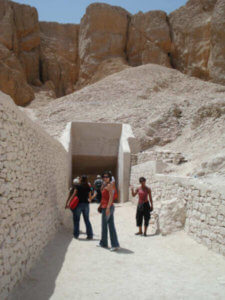 Another landmark that we recommend you to visit is The Valley of the Kings. It is, in fact, an exclusive cemetery for the pharaohs. The most famous of those found (though not the most important Egyptian pharaoh) was Tutankhamon.
Another landmark that we recommend you to visit is The Valley of the Kings. It is, in fact, an exclusive cemetery for the pharaohs. The most famous of those found (though not the most important Egyptian pharaoh) was Tutankhamon.
Only Tutankhaman’s tomb and another have been saved from looters. In countless centuries, many revolts have seen Egypt.And in some of those periods of chaos or simply, when this necropolis was in oblivion, the looters made a big deal.
Although we have all seen photos of the Egyptian pyramids, believe us when we tell you that it is not the same when you are there present. We were overwhelmed with a feeling of wonder and recollection that we can’t really say we’ve experienced in other places.
Final considerations
As we said, these temples and monuments speak of the wonders of ancient Egypt. But we must not lose perspective. There is no doubt that thousands of human beings were used for its construction, apparently in an inhumane way. All for the glory and supposed divinity of a king-god and his mighty clergy.
Those temples are there not only to tell us about the wonders of an ancient civilization, but to remind us how ephemeral it is, in the long run, even the great civilization. And that, in the end, even a king-god can fall into oblivion.
Maybe in two thousand years tourists will visit the ruins of the Burj Khalifa or the Eiffel Tower! Or maybe there’s no trace left… But perhaps the ancient Egyptian temples will continue to be erected in defiance of the tempo.
